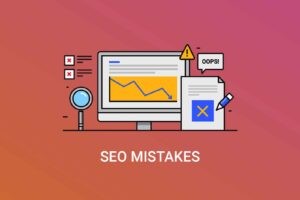In the ever-evolving digital landscape, creating a well-designed website is crucial for success. Whether you’re a business owner, marketer, or designer, a website’s design can make or break your ability to engage visitors, build trust, and convert them into customers. While many website owners focus on aesthetics, it’s equally important to consider functionality, user experience (UX), and SEO. After all, a beautiful website is useless if it frustrates users or fails to perform well on search engines.
In this comprehensive guide, we’ll explore 10 common website design mistakes and provide practical advice on how to avoid them. By recognizing these pitfalls and implementing the right design principles, you’ll be able to enhance user engagement, boost SEO rankings, and ensure your website provides a seamless experience for your audience.
1. Ignoring Mobile Responsiveness

As mobile usage continues to rise, mobile responsiveness has become one of the most critical aspects of web design. With more than half of global web traffic now coming from mobile devices, websites that aren’t optimized for mobile will struggle to retain visitors. Mobile-first design is no longer a luxury but a necessity.
Why It Matters
Non-responsive websites not only frustrate mobile users but also harm your SEO rankings. Google, for instance, uses mobile-first indexing, meaning it predominantly uses the mobile version of your site for ranking and indexing. If your website isn’t mobile-friendly, it may rank lower in search results, leading to decreased visibility.
Additionally, poor mobile design results in higher bounce rates as users may find it difficult to navigate, read text, or interact with your website on smaller screens. User retention and engagement are directly tied to how mobile-friendly your site is. A smooth mobile experience enhances the likelihood of users staying longer, engaging with content, and converting.
How to Avoid This Mistake
To ensure your website is mobile-responsive, implement a responsive design that adjusts to different screen sizes and devices. Use viewport settings and set breakpoints in your CSS to accommodate varying screen resolutions. Touch-friendly navigation is also a must—buttons and links should be large enough to tap without frustration. Finally, test your site across a variety of mobile devices to make sure it offers a consistent, high-quality experience.
2. Overloading with Content
It’s easy to fall into the trap of thinking that more content equals more value, but overloading a website with excessive text, images, or media can be detrimental to both user experience and SEO. A website overflowing with content becomes overwhelming, making it harder for visitors to find the information they need.
Why It Matters
Excessive content leads to cluttered design, negatively impacting both readability and site performance. Long paragraphs of text, large images, and auto-playing videos can slow down your page load speed and make your site difficult to navigate. Visitors may become frustrated and leave your site, leading to higher bounce rates. On the SEO front, content overload can also confuse search engines, making it difficult to determine the most important parts of your content.
Moreover, users often skim through websites. If there’s too much information in one place, they may miss key messages, calls-to-action, or important products. The experience will feel overwhelming, causing potential customers to disengage before they even get the chance to explore what you offer.
How to Avoid This Mistake
To avoid content overload, focus on a clear content hierarchy. Prioritize important information and break it down into digestible sections. Streamline your content by removing unnecessary or repetitive text, and use white space strategically to allow for easier reading. Ensure that the text-to-image ratio is balanced and avoid overwhelming your audience with large, heavy media files. Optimize images and other media to reduce load times, which will also help with SEO.
3. Poor Navigation Design
Website navigation is one of the most critical aspects of user experience. If visitors cannot easily find the information they’re looking for, they’re more likely to leave your site. Confusing navigation can result in high bounce rates and low user engagement, significantly hurting your conversion rates.
Why It Matters
A poor navigation structure makes it difficult for users to understand your website’s architecture, and ultimately, it becomes frustrating to interact with your site. If users can’t quickly find what they’re looking for, they may abandon your site and turn to a competitor. Clear and intuitive navigation, on the other hand, helps users stay on your website longer and engage more with your content.
How to Avoid This Mistake
Simplify your website’s navigation by ensuring that it’s intuitive and easy to follow. Stick to a clear and logical site structure, making sure that key pages like your homepage, product pages, and contact page are easily accessible. Use breadcrumb navigation so users can easily trace their steps back to previous pages. A sticky header can also enhance navigation on long pages by keeping the main menu in view as users scroll.
Incorporate clear calls-to-action (CTAs) throughout your website to guide users towards important goals, such as making a purchase or signing up for your newsletter. Lastly, make sure your navigation is mobile-friendly, as small screen sizes can make navigation challenging.
4. Slow Website Load Times
Page load speed is a critical factor that affects both user experience and SEO rankings. A slow website frustrates users, increases bounce rates, and decreases conversions. It also negatively impacts how search engines rank your site.
Why It Matters
In today’s fast-paced digital world, users expect websites to load quickly. Studies have shown that a delay of just 2 seconds in page load time can increase bounce rates by up to 50%. This means that if your website is slow to load, you’re likely losing half of your potential visitors before they even have a chance to explore your site.
From an SEO perspective, Google Core Web Vitals focuses on factors like loading speed, interactivity, and visual stability. Websites that fail to meet these metrics are likely to experience lower rankings on search engine results pages (SERPs).
How to Avoid This Mistake
To improve your website’s load time, start by optimizing images to reduce their file size without sacrificing quality. Use caching to store frequently accessed data, so your pages load faster for repeat visitors. Implement lazy loading, which delays loading of images or videos until the user scrolls to them, reducing the initial load time. Additionally, minimize the size of JavaScript and CSS files by minifying them, and use a content delivery network (CDN) to deliver content from servers closer to your users.
5. Ignoring SEO Principles in Design

SEO should never be an afterthought in website design. Integrating on-page SEO principles, such as meta tags, title tags, and alt text, from the beginning ensures that your site is optimized for search engines and easily discoverable by users.
Why It Matters
A beautiful website won’t help if it’s not optimized for search engines. If you fail to consider SEO best practices, your website will struggle to rank for relevant keywords. Important on-page SEO elements like alt text for images, meta descriptions, and H1 tags all contribute to better indexing by search engines, which improves your visibility and ranking on Google.
Moreover, good SEO helps create a better user experience. By using structured data and properly labeled content, you make it easier for visitors to find what they need, increasing user engagement and reducing bounce rates.
How to Avoid This Mistake
Integrate SEO into your website design process from the outset. Ensure every page has relevant title tags, meta descriptions, and well-structured content with appropriate H1 and H2 tags. Use alt text for images and optimize your URLs to be descriptive and keyword-rich. Ensure your internal linking structure is coherent, as it helps both users and search engines navigate your website more effectively.
6. Inconsistent Design Elements
Inconsistent design can confuse users and weaken your brand identity. Typography, colors, and UI elements should be uniform across your entire site to create a seamless, professional experience.
Why It Matters
When a website uses multiple fonts, mismatched colors, or different button styles, it can make the website feel disjointed and unprofessional. Design consistency helps establish trust with visitors and enhances their experience. A unified design ensures that users recognize your brand and understand how to interact with your site.
How to Avoid This Mistake
Establish a design system with a clear style guide that dictates the colors, fonts, and other design elements used throughout your website. Stick to a color palette and consistent typography choices that reflect your brand’s personality. UI consistency is key—buttons, forms, and other interactive elements should all look and behave similarly to avoid confusion.
7. Lack of Accessibility

Web accessibility is often overlooked but is crucial for creating an inclusive website. Websites that aren’t accessible to people with disabilities limit their audience and may also face legal consequences. Moreover, websites that adhere to accessibility guidelines often perform better in SEO.
Why It Matters
Not adhering to WCAG (Web Content Accessibility Guidelines) can result in a website that is difficult for users with disabilities to navigate. Accessibility issues may include poor contrast, lack of keyboard navigation, and non-descriptive alt text for images. For SEO, Google has increasingly emphasized accessible websites and considers accessibility features as part of its ranking algorithm.
How to Avoid This Mistake
Make your website accessible by ensuring that it meets WCAG standards. Implement features like screen readers and keyboard navigation so users with visual impairments or limited mobility can navigate your site. Choose accessible fonts with adequate contrast against the background, and ensure all images have alt text that describes their content. Regularly audit your site for accessibility issues using tools like WAVE or Google Lighthouse.
8. Not Testing Across Multiple Browsers
Browser compatibility is a critical aspect of web design that many overlook. A site that works well on one browser may not render properly on others. Cross-browser compatibility ensures that your website provides a consistent user experience across all browsers.
Why It Matters
Different browsers interpret HTML, CSS, and JavaScript differently. If your website isn’t compatible with all major browsers (Chrome, Safari, Firefox, Edge, etc.), users may encounter broken layouts, missing content, or poor functionality, leading to a poor experience. This can frustrate users and harm your site’s SEO performance.
How to Avoid This Mistake
Test your website across multiple browsers using tools like BrowserStack or CrossBrowserTesting. Make sure that your website renders correctly and functions smoothly across various browsers and devices. Pay attention to potential cross-browser issues, such as styling conflicts or broken JavaScript functionality, and use browser developer tools to troubleshoot and fix them.
9. Overuse of Animations and Effects
Animations and special effects can enhance the user experience, but overusing them can lead to performance issues and distractions. The key is to strike a balance between aesthetics and functionality.
Why It Matters
Excessive animations can slow down your website and reduce its performance, especially on slower devices or internet connections. Distracting animations can also take the focus away from the primary content or calls-to-action (CTAs) on the page, causing users to disengage.
How to Avoid This Mistake
Limit animations to only those that enhance the user experience or provide feedback. Use CSS animations and motion UI to add subtle interactions that don’t affect performance. Avoid heavy parallax scrolling or overuse of loading animations. Remember, performance should always come before decoration.
10. Ignoring User Feedback
User feedback is essential for ongoing website improvement. Without it, you may miss valuable insights about your site’s performance, usability, and overall user experience. Listening to your users helps ensure that your website continually meets their needs.
Why It Matters
User feedback helps identify pain points in your website’s design, content, or functionality. Ignoring this feedback can result in a stagnant site that doesn’t evolve to meet user expectations. Websites that adapt based on user insights tend to perform better in terms of engagement, conversion rates, and SEO.
How to Avoid This Mistake
Collect user feedback through surveys, A/B testing, and heatmaps. Implement regular usability testing and gather customer insights to identify areas for improvement. Use tools like Google Analytics to track user behavior and determine which elements of your website need optimization. Always iterate and improve your website based on user input.
Conclusion: A Guide to Perfect Web Design
Avoiding these common website design mistakes is essential for creating a high-performing, user-friendly website. By focusing on mobile responsiveness, content strategy, navigation, SEO, accessibility, and user feedback, you can ensure your website meets the needs of both your users and search engines. Optimization is key to providing an exceptional user experience that leads to higher engagement, conversions, and SEO rankings.
Incorporate these best practices to ensure that your website not only looks great but also works efficiently across devices and platforms. With the right design principles in place, your website will become a powerful tool for building brand credibility, attracting traffic, and driving business growth.
FAQ Common Website Design Mistakes
1. Why is avoiding common website design mistakes important?
Avoiding design mistakes ensures a better user experience, improves SEO rankings, and increases engagement, ultimately helping your website achieve its goals.
2. What are some examples of common website design mistakes?
Examples include slow-loading pages, poor navigation, lack of mobile responsiveness, cluttered layouts, and unclear calls to action.
3. How can I improve my website’s navigation?
Use a simple, intuitive menu structure, include a search bar, and organize content logically to make navigation seamless for users.
4. What is mobile responsiveness, and why is it necessary?
Mobile responsiveness ensures your website looks and functions well on all devices, including smartphones and tablets. It’s crucial as most users browse websites on mobile devices.
5. How can I fix slow-loading web pages?
Optimize images, use a reliable hosting service, minimize code, and leverage caching to improve your website’s loading speed.

Informative post. Similar to what I discuss at
https://konabet-ar.top/.